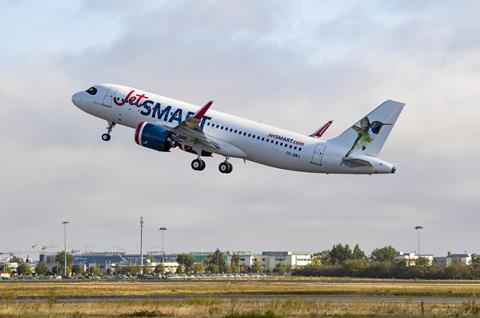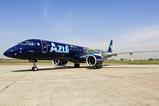After launching domestic service in Colombia last month, JetSmart chief executive Estuardo Ortiz is already marching toward his next conquest – Argentina – with the goal of taking advantage of seismic economic and regulatory changes.
The country at the south-eastern end of the South American continent with a population of 46 million – the third-largest in the region – has been an elusive goal for airlines in recent years, and a risky one. One economic crisis has followed another, resulting in political instability and widespread social unrest.
But now, the winds are changing.
“It’s a new Argentina,” Ortiz tells FlightGlobal on the sidelines of an IATA conference in Santiago, Chile on 11 April. “The macroeconomic change that the government is implementing is yielding results very quickly. The drop in inflation is material and the dollar is stabilising.”
That is good news for the aviation industry, whose costs usually are calculated in dollars, but whose revenue is earned in notoriously shaky Argentine pesos.
In addition, Ortiz says that regulatory shifts will enable the carrier – and others – to launch new routes more easily. The government recently granted Indigo Partners-backed JetSmart permission to fly between Buenos Aires’ city airport Aeroparque Internacional Jorge Newberry and Montevideo, Uruguay, which it will begin to serve twice daily in May. In addition, the ultra-low-cost carrier was recently granted two new routes between Argentina and Brazil.
“There are concrete indications that the market will open further. There’s a new aeronautical code in development, to bring Argentina to the modern world in terms of regulation,” he adds. “It’s a potential transformation of the aviation model in one of the biggest countries in the region.”

JetSmart currently operates 14 domestic and 10 international routes in Argentina, with eight of its 36 Airbus A320 family aircraft that are registered on its Argentine air operator certificate (AOC). That operation could double in size sooner rather than later.
Another regulatory change in discussion is that of aircraft interchange – using aircraft for domestic service that are registered in other countries – that would allow JetSmart to utilise its fleet more flexibly across the continent.
JetSmart, launched in 2017 and headquartered in Santiago, Chile, was the first ultra-low-cost carrier in Latin America. It adopted the no-frills formula that Indigo has successfully developed with brands like Frontier Airlines in the USA and Wizz Air in Europe. That formula calls for strict adherence to the two most important features of a successful budget airline: high efficiency and strict cost control.
It now operates under four AOCs across the continent – in Chile, Colombia, Peru and Argentina - allowing it to offer domestic services across many of the region’s most populous countries except Brazil. It flies 79 routes, 52 domestic and 27 international, criss-crossing eight countries on the continent. Across its units, the carrier has rapidly ramped up, and Ortiz sees the airline expanding to 50 aircraft within the next two years.
In 2023, JetSmart transported 8.5 million passengers, 20% more than 2022, and it expects to grow 50% more this year. By 2028, just over a decade after it launched, JetSmart aims to have transported 100 million passengers.
ARGENTINE DREAMS
In the past decades, volatile politics in Argentina have made it difficult for new entrants to stand up to and thrive alongside state-owned Aerolineas Argentinas. The past few years have been extraordinarily challenging, and have underlined that growth in the country cannot be taken for granted.
Low-cost competitor Flybondi launched operations in 2018, with JetSmart following shortly thereafter, amid air transport liberalisation moves in the country under then-president Mauricio Macri. That period also saw the launch of Argentinian operations from Avianca and Norwegian, as new ventures aimed to capitalise on the scrapping of minimum domestic fare rules in the country. They all launched scheduled service on routes that had previously been dominated by Aerolineas Argentinas and its domestic subsidiary Austral Lineas Aereas
To accommodate the influx of the discount airlines, the government opened a secondary airport at El Palomar, on the outskirts of the sprawling Argentine capital, for low-cost carriers to duke it out.
But Argentina’s liberalised airline sector struggled to take off as familiar challenges, including high taxes, currency depreciation and hyper-inflation, persisted. Even before the pandemic brought wider services to an abrupt halt, Avianca Argentina had ceased operations and Norwegian sold its fledgling operation to JetSmart.
Also, in late 2019, in a political earthquake, Argentine voters ousted the conservative, business-friendly Macri government, choosing instead the leftist protectionist rule of Alberto Fernandez and running mate (and Macri’s Peronist predecessor), Cristina Fernandez de Kirchner. The Peronists walked back the Macri government’s reforms in the ensuing months, choosing instead to prop up Aerolineas Argentinas and help it merge with Austral in 2020, in the wake of the Covid-19 crisis.
In late 2023, the libertarian Javier Millei came to power in an unexpected upset win over the socialist candidate, promising “shock therapy” to the ailing economy which had seen inflation of up to 250%. In his first four months in power, Millei has cut the value of the currency, and heavily curtailed public spending as well as transportation, fuel and energy subsidies.
For its part, JetSmart has continued to see high load factors in Argentina, signaling that demand has not dropped off, despite the economic pressures on the population.
“It’s now just a question of how much we could actually grow,” Ortiz says, adding that the industry should see a clearer path forward as soon as the second half of 2024.
According to IATA statistics, while the United States shows an average of 2.6 trips per person per year, in Argentina it’s just 0.6, about half of neighbouring Chile’s 1.2 trips per year. So numerous carriers are assessing the future potential of a liberalised market.
“In a football analogy, this is like minute five, and we’re still have the whole first half and the second half to play, but it does look encouraging,” he says.
COLOMBIAN START
JetSmart’s Colombian operation, which began operating flights in March from a Bogota base, will expand to 15 routes and seven aircraft in the coming weeks, up from eight routes and four aircraft.
The successful launch of a new low-cost option in South Amerca’s second most populous country was made possible following the demise of two smaller carriers,Viva Air and Ultra Air, last year.
The airline will open a second base in Medellin in June, and is targeting two million passengers in its first year of operation in the country. Colombia, too, has a below-average per capita trip figure of 0.78, according to IATA statistics, making it another attractive market for commercial air transport expansion.
“Scaling up our operation in Colombia is a priority for this year,” he says.

XLR STRETCH
According to Cirium fleets data, JetSmart still has 99 aircraft on order with Airbus, of which 16 are XLR models Ortiz says. Those are expected to join the fleet from 2026. With those long-range models, the airline can look to reach points even further north, and Estuardo Ortiz is already mapping out his strategy.
“US to South America is a tremendously big market,” Ortiz says. “The US will probably be part of the plan down the road, it’s too big of a market to ignore.”
That said, he’s also conscious of not stretching the carrier’s capabilities too thin, as it continues to scale up its operations. He’s playing his partnerships first, which gives JetSmart some room to breathe. Last June JetSmart and American Airlines launched a codeshare alliance which has already been “very efficient” for the Chilean airline, and from which it hopes to benefit further.
That alliance includes a minority investment by American in JetSmart, which has helped support the company’s continued development and expansion in its home region.
Is JetSmart jockeying to become the largest airline on the continent, surpassing even local behemoth LATAM Airlines Group?
“I’m not sure we will get to that, but I would like for us to be the preferred and most valuable airline in the region,” he says. “JetSmart created an important disruption in the market so that today the low cost model is offered by practically all airlines in Latin America. That is new.”
























